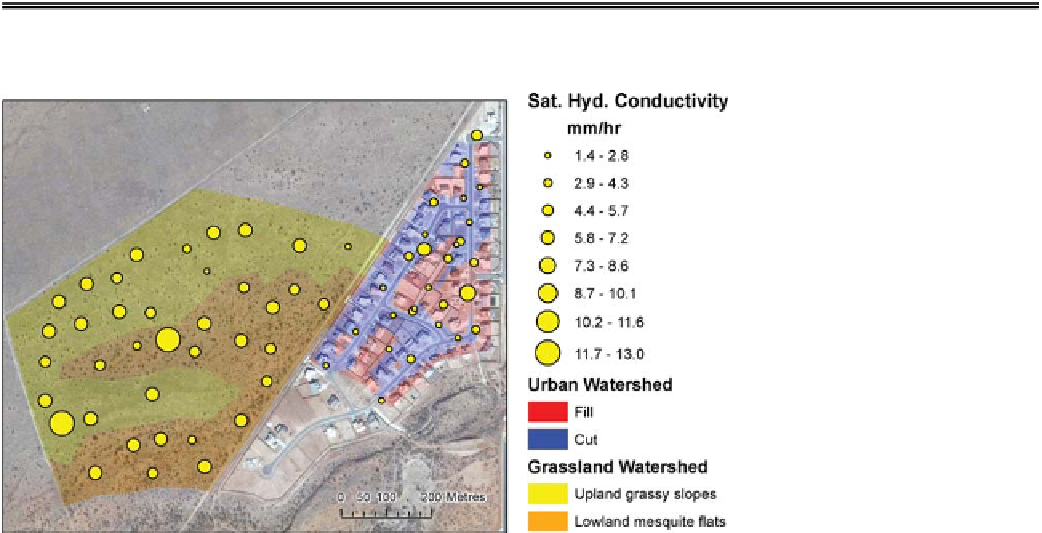Geography Reference
In-Depth Information
Table 11.14. Geometric mean and coefficient of variation for the catchment-scale (from SCEM optimisation) and
point-scale (from tension infiltrometer measurement) estimates of K
s
Urban catchment
Grassland catchment
Mean K
s
, mm/hr
Coeff. var.
Mean K
s
, mm/hr
Coeff. var.
Catchment-scale
9.5
0.29
25
0.58
Point-scale
2.9
0.55
6.2
0.56
AGWA soil texture
26
—
26
—
The catchment-scale values are a sample of values optimised individually for 20 rainfall events. Point-scale values are a spatial sample.
Figure 11.69. Tension infiltrometer
measured saturated hydraulic
conductivity values and their
respective locations. In the urban
catchment, pink regions denote areas
of soil fill for site preparation and
blue areas denote sites of soil cuts.
Closer examination of the infiltrometer measurements
indicated that site preparation for the urban catchment
did have a substantial impact on the measured K
s
(
Figure 11.69
). Analysis of the optimised results resulted
in three important findings. First, the effective saturated
hydraulic conductivity determined using SCEM optimisa-
tion decreases from about 25 mm/hr in the grassland area
to 9.5 mm/hr in the urban area, a change that is confirmed
in direction, but not magnitude, by tension infiltrometer
measurements, which average 6.2 and 2.9 mm/hr in the
grassland and urban catchments, respectively. Second,
assuming that prior to development the two catchments
had identical infiltration properties, it is estimated that
about 17% of the increase in runoff from the urban area
comes from a change in pervious area properties (Kennedy
et al.,
2012
). In other words, the expected volume of runoff
would be 17% less than what was measured if rainfall
infiltration occurred at the same rate as it did prior to
development. Third, the values for the point-scale and
optimised catchment-scale K
s
estimates are similar for the
urban catchment, but much less than would be expected
from estimates based on soil texture (
Table 11.14
). The
greater difference between the model-optimised and meas-
ured K
s
estimates in the grassland catchment is attributed to
compensating parameter adjustments by SCEM for model
error, parameter error and (or) data error, exacerbated by
the very small runoff coefficient.
Discussion
There are several important results of this study applicable
to PUB. The first is that urbanisation impacts on catchment
runoff response are not limited solely to the amount of
impervious area that is constructed. In developments where
heavy earth-moving and compaction equipment is used for
site preparation, the developed infiltrating areas have a
substantially lower rate of infiltration than adjacent undevel-
oped areas. In this study, that decrease in K
s
resulted in an
additional 17% increase in runoff volume beyond that
created by impervious surfaces. Infiltration rates in these
compacted soils may recover over time but additional meas-
urements will be required. In addition, several strategic




Search WWH ::

Custom Search